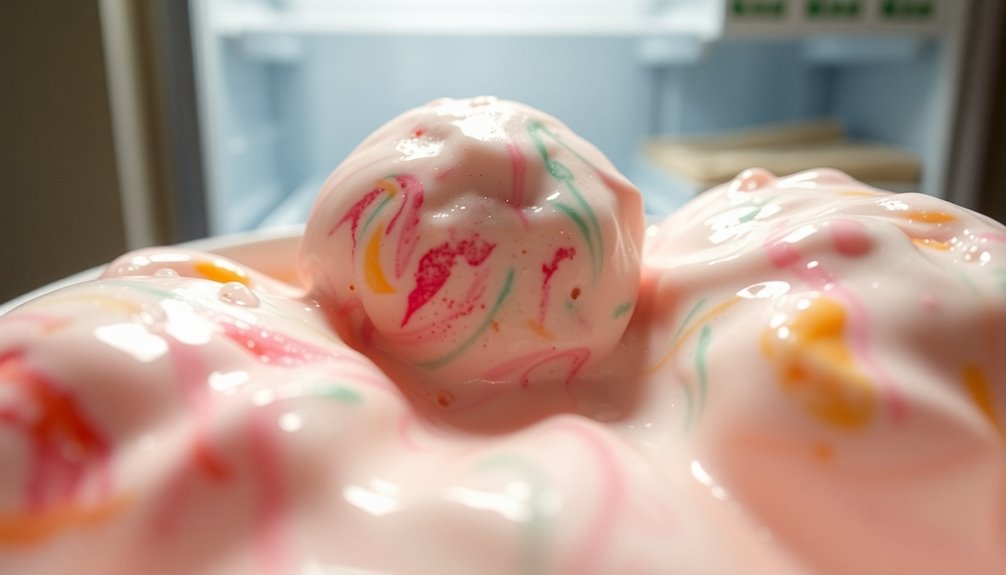Refreezing melted ice cream isn’t recommended due to quality and safety issues. When ice cream melts, harmful bacteria can grow if it sits out for over two hours. Refreezing can also lead to grainy textures and off flavors. If you’ve melted ice cream, it’s best to refrigerate it immediately and consume it soon. Learning how to store ice cream properly can help you avoid these problems in the future and enhance your enjoyment.
Key Takeaways
- Avoid refreezing melted ice cream if it has been left out for more than two hours to prevent bacterial growth.
- Check for signs of melting and refreezing, such as grainy texture or icy crust, which indicate compromised quality.
- Store ice cream at a stable temperature between -10°C to -12°C (14°F to 10°F) to maintain optimal consistency.
- Seal containers tightly to reduce air exposure and prevent freezer burn when storing ice cream.
- Consume homemade ice cream within one month for the best taste and safety, avoiding refreezing if it has melted.
Understanding the Risks of Refreezing Melted Ice Cream
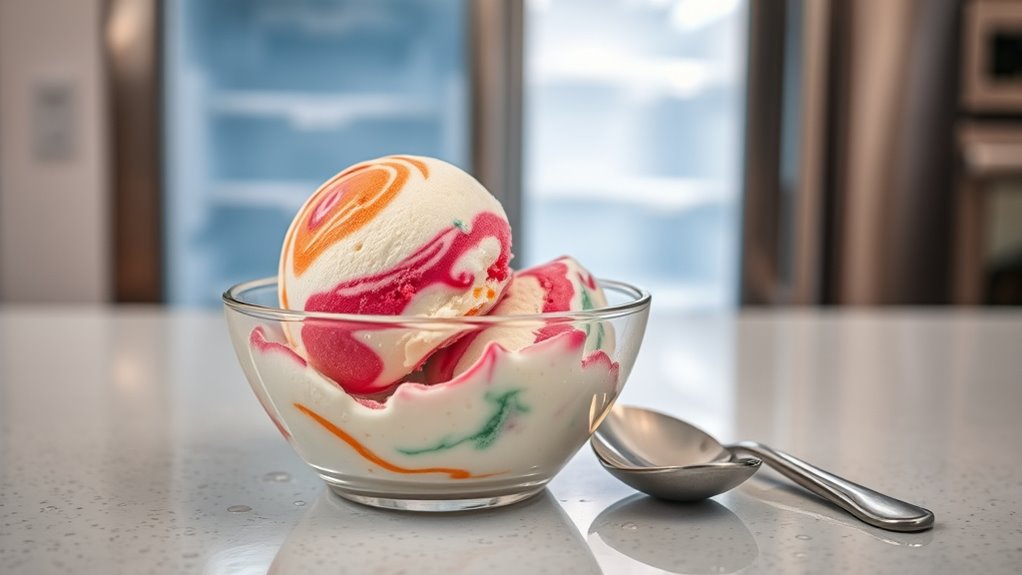
When you refreeze melted ice cream, you’re not just risking its taste and texture; you’re also exposing yourself to potential health hazards. If melted ice cream sits at room temperature for over two hours, harmful bacteria like listeria can thrive.
The CDC identifies the “Danger Zone” for perishable food as between 40°F and 140°F, where bacteria multiply rapidly. Refreezing doesn’t eliminate these bacteria, increasing your risk of foodborne illness.
Additionally, melted and refrozen ice cream often develops larger ice crystals, resulting in a grainy consistency that compromises quality.
To safeguard your health, it’s essential to monitor the temperature and duration of exposure to warmth, adhering to proper food safety practices when handling perishable food like ice cream.
Identifying Signs of Melted and Refrozen Ice Cream

To identify melted and refrozen ice cream, look for specific signs that indicate a drop in quality. Here are four key indicators:
- Custard-like consistency: If your ice cream has a thick, custard-like texture, it’s likely melted and refrozen.
- Grainy texture: Refrozen ice cream often develops a grainy texture due to larger ice crystals, compromising its original smoothness.
- Visual indicators: An icy crust or surface frost suggests temperature fluctuations, signaling that it’s been refrozen.
- Changes in taste: Refrozen ice cream usually tastes less enjoyable, and if it’s been left out for more than two hours, it might be unsafe to consume.
Keep an eye out for these signs to guarantee you’re enjoying quality ice cream!
The Impact of Texture on Ice Cream Quality
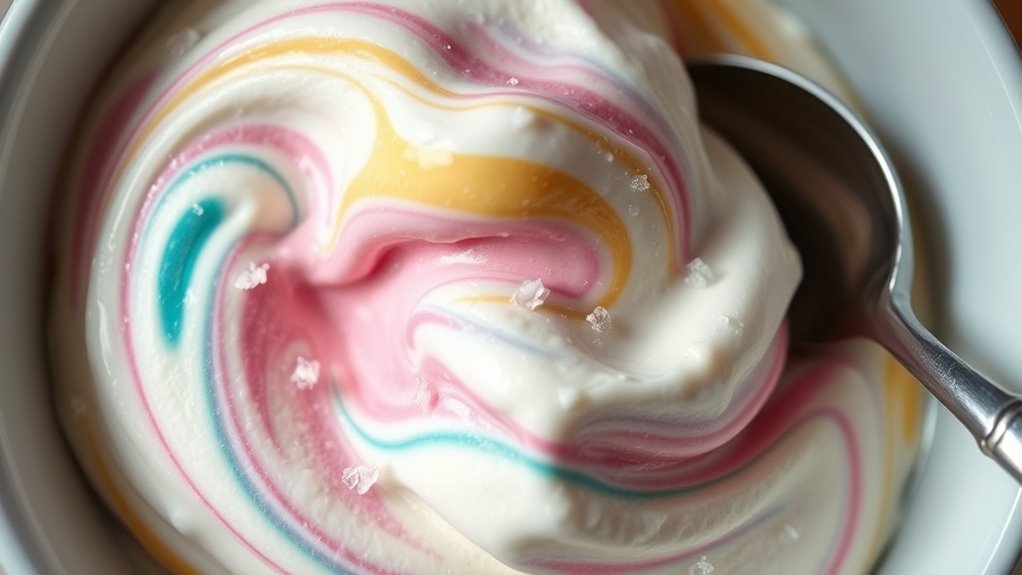
The texture of ice cream plays an essential role in determining its overall quality, as it directly affects your enjoyment.
When ice cream melts, smaller ice crystals combine into larger, grainy ones, compromising the smoothness you love. Refreezing causes a denser consistency due to lost air and the formation of these bigger ice crystals, which can lead to an unpleasant mouthfeel.
Instead of the creamy experience you expect, you might encounter crunchy textures that detract from the overall quality. These changes in texture are key indicators that your ice cream has undergone melting and refreezing.
To truly savor your treat, it’s best to enjoy ice cream before it melts, preserving its delightful consistency and mouthfeel.
Health Concerns Associated With Melted Ice Cream

Enjoying ice cream at its best means being mindful of how you handle it. Here are some health concerns you should consider:
Enjoying ice cream safely requires careful handling to avoid health risks.
- Bacterial Growth: Ice cream left in the Danger Zone (40°F to 140°F) for over 2 hours can harbor harmful bacteria.
- Foodborne Illness: Refreezing melted ice cream doesn’t eliminate bacteria, increasing your risk of foodborne illness.
- Raw Eggs: Artisan ice creams with raw eggs are particularly risky when melted for long periods.
- Toxins: Consuming refrozen ice cream can lead to health issues due to toxins that freezing doesn’t destroy.
To keep your ice cream safe, be cautious about the temperature range and how long it sits out.
Best Practices for Storing Ice Cream
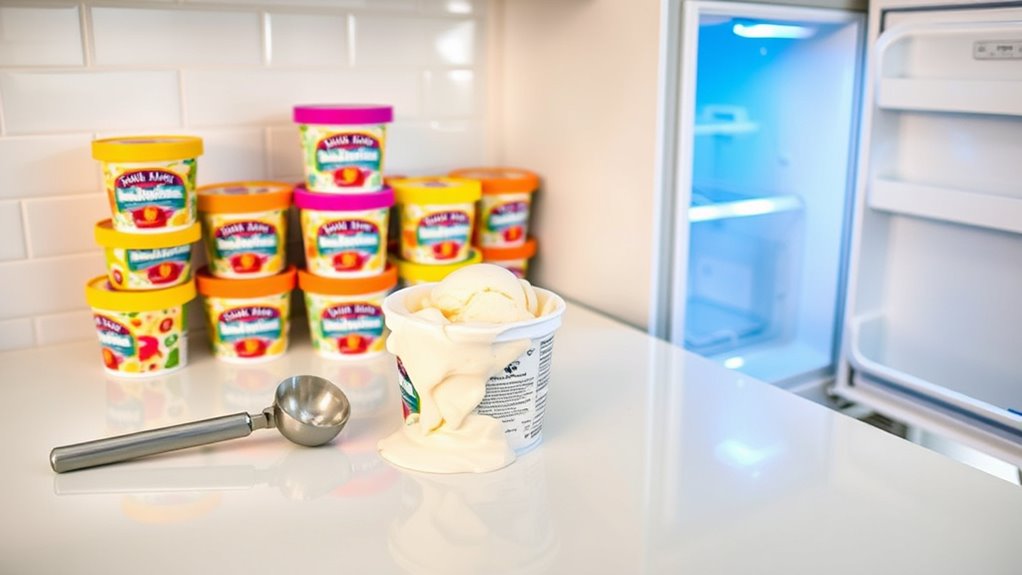
When ice cream is stored properly, you can enjoy its creamy goodness for longer. To achieve ideal preservation, keep your best ice cream at a stable temperature between -10°C to -12°C (14°F to 10°F) in the back of the freezer.
Always seal the container tightly to prevent air exposure, which causes freezer burn and ruins the creamy texture. Avoid frequent freezer openings to maintain quality.
If the cream has been melted, place it in the refrigerator immediately to slow bacterial growth, ensuring safety for later use.
For homemade or artisan varieties, consume them within one month for the best taste. Following these hygiene regulations will help you refreeze ice cream safely and enjoy it without concerns.
Creative Ways to Use Melted Ice Cream

Melted ice cream doesn’t have to go to waste; it can be a delicious ingredient in your kitchen. Here are some creative ways to use it:
Don’t let melted ice cream go to waste; it can add a delightful twist to your favorite recipes.
- Baked Desserts: Pour melted ice cream over your favorite baked goods instead of sauces to enhance flavor.
- Cake Recipes: Replace milk with melted ice cream in a 1:1 ratio for a sweet twist on traditional cakes.
- 3-Ingredient Crème Brûlée: Mix melted ice cream with an egg yolk and bake until set for a simple, indulgent treat.
- Smoothies: Blend melted ice cream into smoothies for a quick treat that minimizes waste while balancing sweetness.
Get creative and enjoy these delicious ideas!
Making the Most of Your Ice Cream Experience
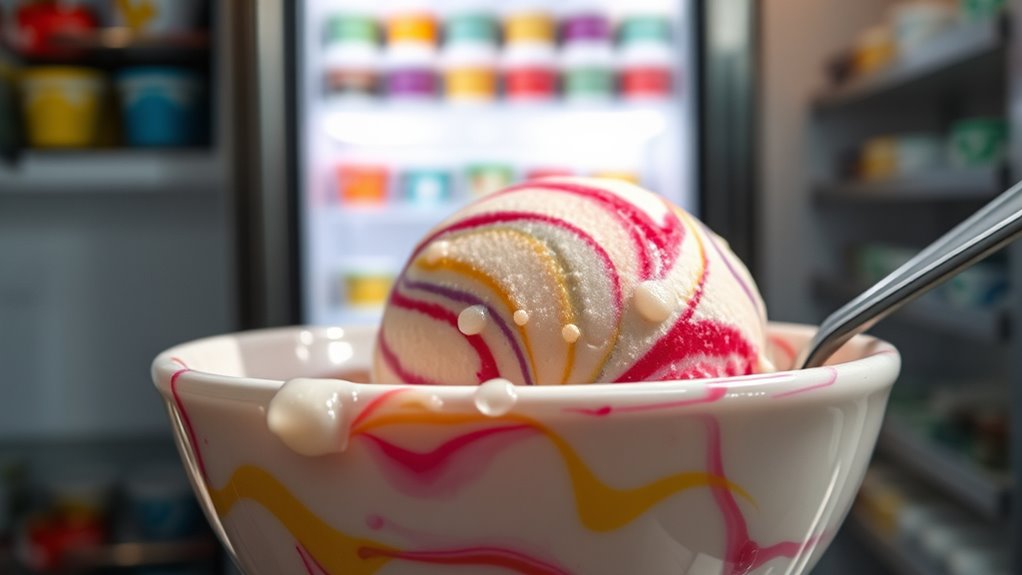
To truly enhance your ice cream experience, consider how you can creatively use slightly melted ice cream in your favorite recipes. You can repurpose it by incorporating melted ice cream into cakes or pouring it over baked desserts for added flavor.
If it’s still cool and hasn’t been out for more than two hours, you can safely refreeze it. Keep in mind that refreezing may alter the texture, creating larger ice crystals. To combat this, try re-churning the mixture to improve air incorporation before freezing it again.
Embracing melted ice cream not only prevents waste but also inspires innovative desserts, transforming your ice cream experience into delightful culinary creations. Enjoy experimenting! Additionally, using melted ice cream as an ingredient can add a unique flavor profile to frozen yogurt dishes, making them even more enjoyable.
Frequently Asked Questions
Is It Okay to Refreeze Melted Ice Cream?
You might wonder if it’s okay to refreeze melted ice cream. If it’s only slightly melted and kept cold, you can refreeze it without much worry.
However, if it’s been sitting out at room temperature for more than two hours, it’s best to throw it away to avoid health risks.
How to Make Melted Ice Cream Good Again?
When life hands you melted ice cream, don’t just throw it away!
You can make it good again by using it creatively. Pour it over desserts for a sweet sauce or mix it into baking recipes as a milk substitute.
If it’s still cool, refrigerate it to slow bacteria growth, but avoid leaving it out too long.
Just remember, refreezing might change its texture, so embrace the new experience!
Can You Fix Freezer-Burned Ice Cream?
You can’t really fix freezer-burned ice cream to restore its original texture and taste.
However, you can improve the experience by scraping off the affected areas. While it’s safe to eat, the grainy texture and off-flavors mightn’t be enjoyable.
To prevent this in the future, store your ice cream in an airtight container and keep it at a consistent temperature below -10°C (14°F) to avoid freezer burn altogether.
Is It Okay to Refreeze Melted Ice Cream on Reddit?
When you ask if it’s okay to refreeze melted ice cream on Reddit, the answer’s a bit tricky.
If it’s been left out for more than two hours, it’s best to toss it due to potential bacteria growth.
If it’s only slightly melted and still cold, you might refreeze it, but expect a change in texture and taste.
Always prioritize safety over saving a treat, so check the temperature before deciding!
Conclusion
So, next time you find your ice cream melting in the summer sun, remember the risks of refreezing it. Picture that creamy delight turning icy and grainy, losing its charm. Instead, embrace the moment—scoop it into a tempting milkshake or drizzle it over warm brownies. By treating every scoop with care, you’ll savor the sweet memories and flavors, creating a delightful experience that’s more than just dessert. Enjoy your ice cream adventure!
